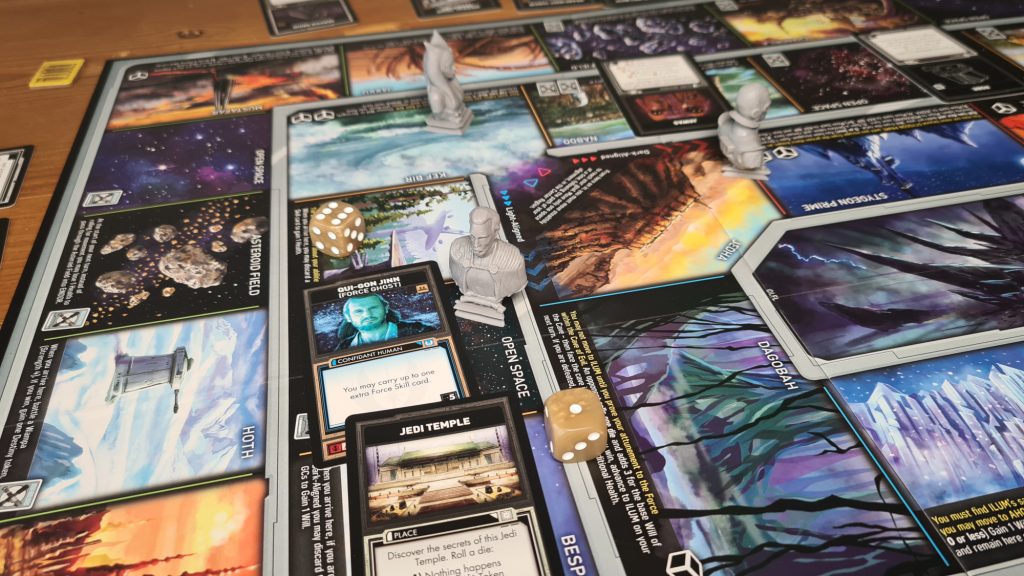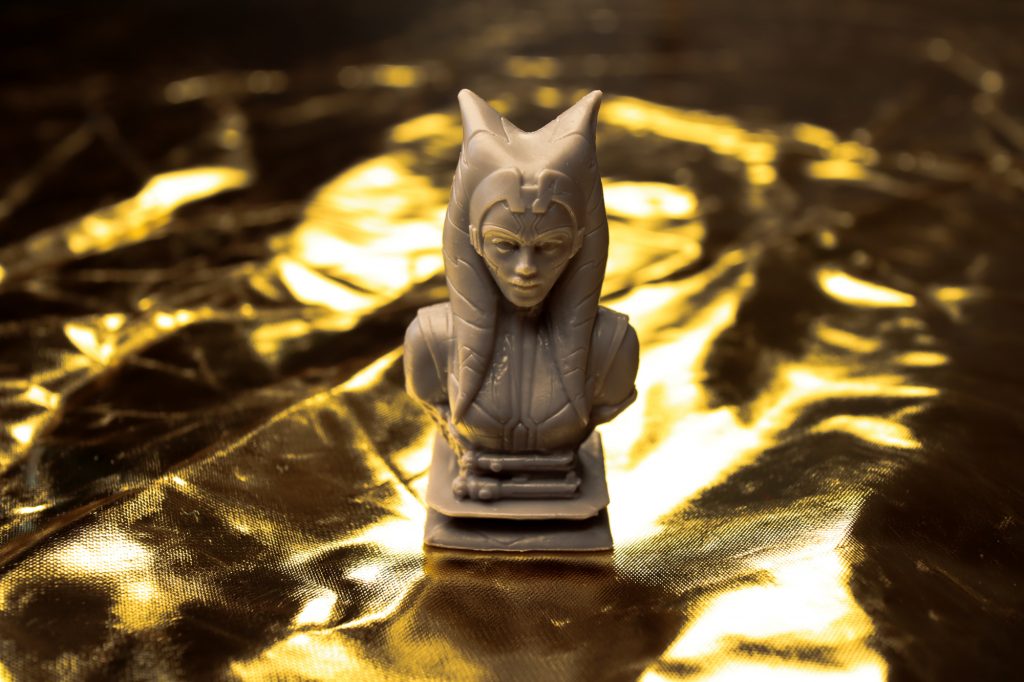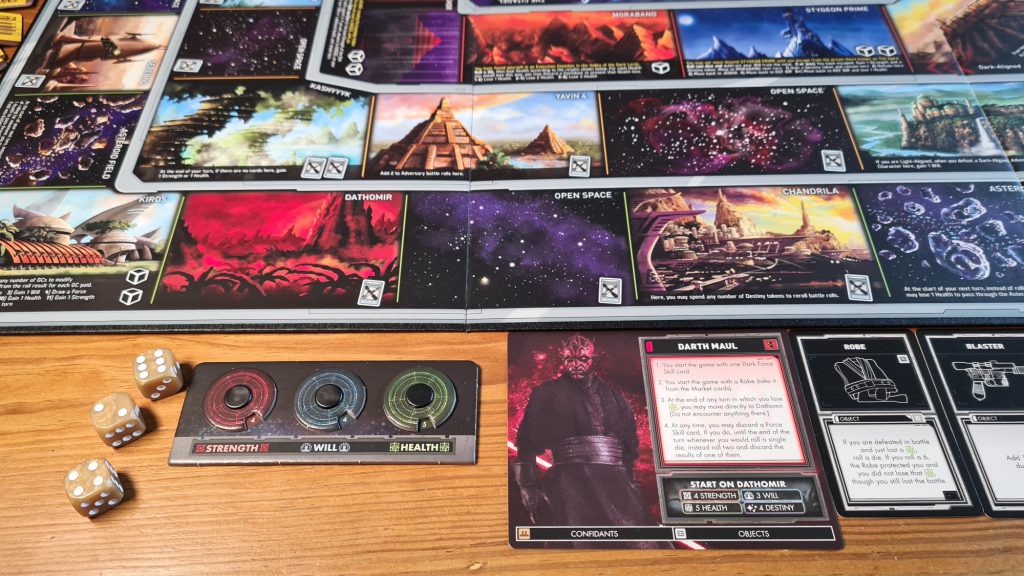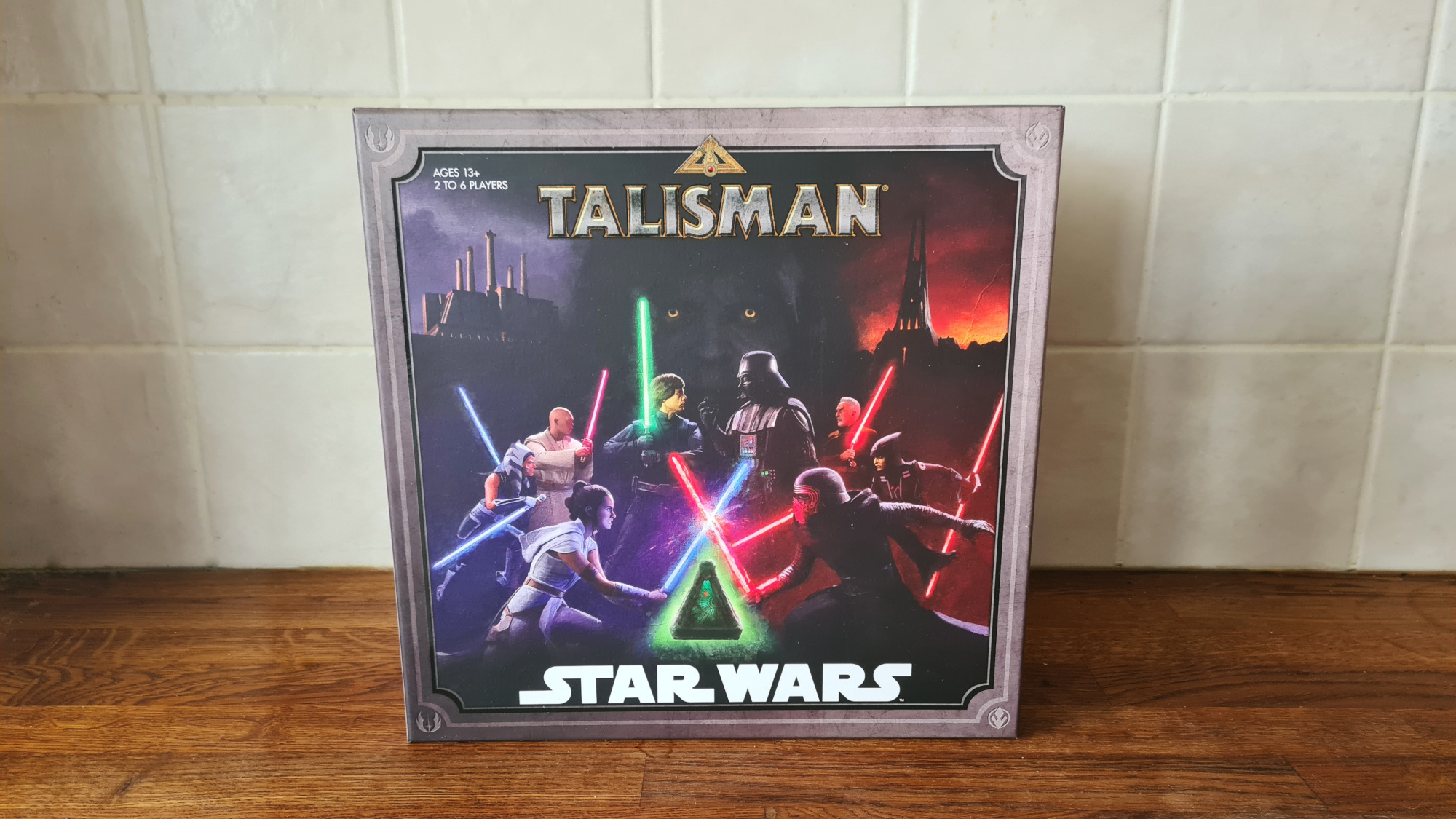Talisman: Star Wars is a brand new game from publisher The Op, where players take up the roles of iconic characters and attempt to face Emperor Palpatine. Based upon Talisman from Robert Harris – originally released back in 1983 – the game sees 2 – 6 players join the dark side or light side. For around 2 hours players will roll dice, visit locations from the Star Wars universe and fight adversaries and even each other. However, does the Force compel you to play more or does it feel like the slowest Kessel run? Let’s find out!
As a general overview players will be taking up the roles of iconic characters, whom are either light aligned or dark aligned. They will be looking to increase their strength and will, as they move around the board and encounter events, characters and more. The board is split into 3 rings, the outer, middle and inner regions – with the eventual aim to get through the inner region to defeat Emperor Palpatine, either to replace him as the ruler or to bring peace to the galaxy.
As written each player is dealt two random character cards, choosing one to play as while returning the other to the box. Fear not fans of specific characters though, there are alternate rules – if everyone agrees characters can be selected from the full range of 12. Players take a stat board, setting the dials to their characters starting strength, will and health values. Each character is a bit different, with some gaining specific market items or force cards, and each gaining a number of destiny tokens and galactic credits. The game then begins, with whoever last saw a Star Wars film or series being the starting player.
A player’s turn is made up of two phases, movement and encounter. To move the active player rolls a six sided die. They can then choose to move either clockwise or counterclockwise around the board that number of spaces. Some cards players obtain during play may allow them to change the value, and players can spend destiny tokens to re-roll a die once. An example of this is the A-Wing, a light aligned vehicle, which allows a light aligned character to add 1 to their rolled movement value.

Depending on where they land the player can encounter the space or an oppositely aligned character on the same space. The majority of the time players will be encountering the space. Often this sees a number of encounter cards drawn equal to the symbols on the space or players having to roll dice to see the outcome of an event. When drawing encounter cards the number is reduced by the number of cards already on the space. For example, Tatooine has 1 card symbol. When landing here players draw a card adding it to the space, unless there is already one there.
Encounters cards come in a number of forms, from events that give galactic credits to adversaries to fight or guides to help you. Depending on your character’s alignment encounters may be useful or something you need to fight. For example, Yoda is a powerful guide for light aligned characters and a tough adversary for dark aligned players. If an encounter is from either different alignment, including neutral, players will have to battle – unless they have a way to evade.
Battling is done by checking the associated stat on the adversary card (Will or Strength) and rolling a single die. General Grievous for example has a Will of 3, which is added to the value on the dice roll. The player then attempts to beat this by rolling a dice and combining the value with their Will value. If the player has the higher number the adversary is defeated. This sees the card claimed as medal points, which can be discarded in multiples of 5 to upgrade your characters stats permanently. Drawing sees nothing happen, whilst losing sees a health lost.
Players do have the option of discarding a destiny token to re-roll a die but the new value must be taken, with no further re-rolling allowed. Battling other players from the opposite alignment is also possible by encountering them, rather than the space. These battles are always strength based, with the winner able to force the loser to lose 1 health, steal an object from them or try to defeat one of their guides.

Objects from robes, which might stop damage being taken, to kyber crystals, that boost stats, can be collected along the journey – some from the market and others coming via the encounter deck. Characters have an object limit of 4, though this can be increased via a service droid, and players can only have one object of the same name. If a player wants to pick up a new object they can drop an old one onto the space they are on to avoid going above the limit.
Over time the spaces around the board have cards left on them, waiting for others to interact with them. After a player’s turn is finished, play then moves onto the next player. If they are skipping a turn then can simply stand their character bust back up, with play moving on again. The game continues until one player manages to not only acquire a Sith Wayfinder and get to The Citadel, they must also then defeat Emperor Palpatine – a will based battle. If successful they win the game and hopefully balance is returned to The Force.
Characters can be killed in Talisman Star Wars. If a character’s health reaches zero then they are eliminated, though the player is not out of the game. Drawing a new character card at random the player keeps any galactic credits and confidants, plus a sith wayfinder if they had one – becoming inherited items. Other bits, such as destiny tokens and medals are returned to the stockpiles / discard pile accordingly. The only difference is that this player gains a random Force card from the deck, rather than one based on their alignment. This system allows a character dying to be a setback, but it doesn’t completely reset a player to zero – so they can still compete.
A lot of Star Wars games feature the iconic characters of Luke Skywalker and Darth Vader, some stretch to the likes of Darth Maul or Mace Windu. Talisman: Star Wars not only features these, included in the 12 playable characters are the likes of Ahsoka Tano and Ezra Bridger, from the animated Clone Wars and Rebels series respectively. Fans will probably quickly notice that the likes of Yoda and General Grievous are not included as playable characters. Plenty of other characters from Yoda and Grievous to Finn and Hondo make the cut as confidants and adversaries though. Each of the 12 characters have different starting locations and stats, they can also be impacted by who else is in the game. On top of this they all have unique powers, which help them in different aspects of the game. While Luke gains bonus force cards at Crait, Maul can flee back to Dathomir when he takes damage. These don’t define the way a character has to be played but can be very helpful if exploited correctly on the journey towards Exegol and the Throne of the Sith.

There is a little barrier of entry to play, the rules. The rulebook does an okay job at stepping players through how to play, though some aspects are only really understood when playing and checking back. From the beginning the rulebook doesn’t help itself. The images for setup show a different number of destiny tokens given to Luke Skywalker from one page to the next. Following the rules as written gamers shouldn’t struggle but it is something that could confuse new players. Another way the rulebook could have been improved are in the examples given. When battling is explained three strength based adversaries are imaged but not a single will based adversary. While they work in identical ways having that clearer in the rules would be beneficial to smooth the learning experience. Past this there are other small rule ambiguities – though these quickly ebb away when playing.
Roll and move gets a pretty bad rap with hobby gamers, as it leaves a lot to the fate of the dice. Combine this with the further rolls for combat and luck of the draw from the encounter deck and there is a lot of randomness outside of players control. There are some ways to mitigate some bad luck, with destiny tokens to re-roll and items to boost stats. Despite this there are choices to be made throughout the experience, from the simple choice of which direction to move to when to drive towards The Citadel and which items to hold onto.
Almost as expected from a game from The Op the components are of high quality. Talisman: Star Wars uses busts to represent the characters, rather than miniatures. While busts aren’t for everyone, they allow the characters to be easily recognised. Their unique silhouettes mean players can distinguish between them all at a moment’s notice. On top of looking stunning, they are solid plastic too – ready for hitting the table time and time again. Not shown on the back of the box are the 6 slightly gold coloured d6 dice. For the most part each player will be rolling a single die, so with the maximum of 6 players everyone has their own – though players would have to pool dice together when needing to roll multiple.
With illustrations of locations from Hoth to Mandalore, even Ahch-To makes the cut, the board is a visual treat for any Star Wars fan. There is enough space for text and some symbology, with the only improvement possible if the text could be written in multiple orientations. The large deck of encounters and then market items and force cards allows for a lot of variety from one game to the next. One odd choice is to include a mixture of artwork styles. From movie stills for characters like Lando, animated stills of a Loth Cat and then basic illustrations for market items – there isn’t consistency. Each looks good on its own but using the mixture is a bit odd.
Talisman Star Wars is one of those “beer and pretzel” style experiences. Some will certainly be put off by the thought of a game lasting around 2 hours that has such a basis in randomness – be that the dice rolls or players getting the encounters they wanted out of the deck. However, you know what you are getting with a Talisman game and it is still an experience that could easily hook Star Wars fans. Fans will love the movie moments encapsulated in the encounters, the vivid locations on the board and get a huge kick out of playing as their favourite characters. If dice aren’t for you then Talisman Star Wars might not be either. If you can get past the randomness, it could be the light weight, entertaining, Star Wars themed, board game you’re looking for, to gather around a table with a group of friends to pass a couple of hours.
(Editor’s Note: Talisman Star Wars was provided to us for the review by Coiledspring Games. We also received a set of promo cards, including the Millennium Falcon, to use with the game. Most retailers should be offering this when they sell the product. The game is currently available in European, Middle Eastern, and African regions.)

